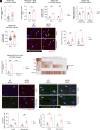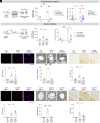Inhibiting 15-PGDH blocks blood-brain barrier deterioration and protects mice from Alzheimer's disease and traumatic brain injury
- PMID: 40397680
- PMCID: PMC12130856
- DOI: 10.1073/pnas.2417224122
Inhibiting 15-PGDH blocks blood-brain barrier deterioration and protects mice from Alzheimer's disease and traumatic brain injury
Abstract
Alzheimer's disease (AD) and traumatic brain injury (TBI) are currently untreatable neurodegenerative disorders afflicting millions of people worldwide. These conditions are pathologically related, and TBI is one of the greatest risk factors for AD. Although blood-brain barrier (BBB) disruption drives progression of both AD and TBI, strategies to preserve BBB integrity have been hindered by lack of actionable targets. Here, we identify 15-hydroxyprostaglandin dehydrogenase (15-PGDH), an enzyme that catabolizes eicosanoids and other anti-inflammatory mediators, as a therapeutic candidate that protects the BBB. We demonstrate that 15-PGDH is enriched in BBB-associated myeloid cells and becomes markedly elevated in human and mouse models of AD and TBI, as well as aging, another major risk factor for AD. Pathological increase in 15-PGDH correlates with pronounced oxidative stress, neuroinflammation, and neurodegeneration, alongside profound BBB structural degeneration characterized by astrocytic endfeet swelling and functional impairment. Pharmacologic inhibition or genetic reduction of 15-PGDH in AD and TBI models strikingly mitigates oxidative damage, suppresses neuroinflammation, and restores BBB integrity. Most notably, inhibiting 15-PGDH not only halts neurodegeneration but also preserves cognitive function at levels indistinguishable from healthy controls. Remarkably, these neuroprotective effects in AD are achieved without affecting amyloid pathology, underscoring a noncanonical mechanism for treating AD. In a murine microglia cell line exposed to amyloid beta oligomer, major protection was demonstrated by multiple anti-inflammatory substrates that 15-PGDH degrades. Thus, our findings position 15-PGDH inhibition as a broad-spectrum strategy to protect the BBB and thereby preserve brain health and cognition in AD and TBI.
Keywords: 15-PGDH; Alzheimer’s disease; blood–brain barrier; neuroprotection; traumatic brain injury.
Conflict of interest statement
Competing interests statement:Y.K., E.V.-R., M.-K.S., J.M.R., N.S.W., S.D.M., and A.A.P. hold (+)-SW033291-related patents, some of which have been licensed and/or optioned to Amgen.
Figures




Comment in
-
15-PGDH inhibition preserves blood-brain barrier integrity and cognition.Proc Natl Acad Sci U S A. 2025 Jul 8;122(27):e2511399122. doi: 10.1073/pnas.2511399122. Epub 2025 Jun 30. Proc Natl Acad Sci U S A. 2025. PMID: 40587805 No abstract available.
References
-
- Geneva: World Health Organization, Global Action Plan on The Public Health Response to Dementia 2017–2025 (World Health Organization, 2017).
-
- van de Haar H. J., et al. , Blood-brain barrier leakage in patients with early alzheimer disease. Radiology 281, 527–535 (2016). - PubMed
-
- van de Haar H. J., et al. , Neurovascular unit impairment in early Alzheimer’s disease measured with magnetic resonance imaging. Neurobiol. Aging. 45, 190–196 (2016). - PubMed
MeSH terms
Grants and funding
- RM1 GM142002/GM/NIGMS NIH HHS/United States
- T32 NS077888/NS/NINDS NIH HHS/United States
- U01 AG073323/AG/NIA NIH HHS/United States
- RF1 AG049479/AG/NIA NIH HHS/United States
- R56 AG075600/AG/NIA NIH HHS/United States
- P30 AG072977/AG/NIA NIH HHS/United States
- P50 DA044123/DA/NIDA NIH HHS/United States
- T32 GM007250/GM/NIGMS NIH HHS/United States
- R21 AG073684/AG/NIA NIH HHS/United States
- R35 CA197442/CA/NCI NIH HHS/United States
- F99 AG083111/AG/NIA NIH HHS/United States
- F30 AG076183/AG/NIA NIH HHS/United States
- R01 AG071512/AG/NIA NIH HHS/United States
- T32 AG071474/AG/NIA NIH HHS/United States
- R01 CA217992/CA/NCI NIH HHS/United States
- T32 GM135081/GM/NIGMS NIH HHS/United States
- R25 CA221718/CA/NCI NIH HHS/United States
- RF1 AG056363/AG/NIA NIH HHS/United States
- I01 BX005976/BX/BLRD VA/United States
- P30 AG072959/AG/NIA NIH HHS/United States
- R01 LM013067/LM/NLM NIH HHS/United States
LinkOut - more resources
Full Text Sources
Medical
Miscellaneous

